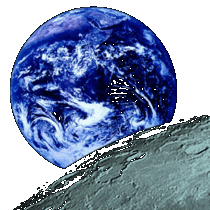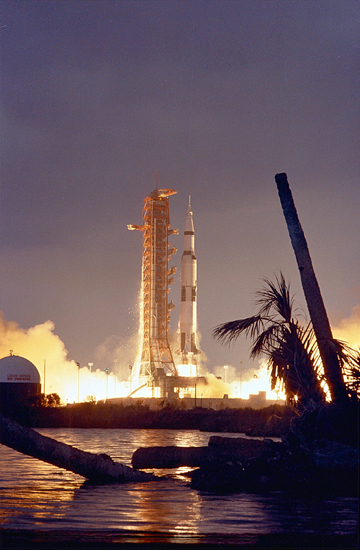
|
|
 |
|
THE
APOLLO PROGRAM was designed to land humans on the Moon and
bring them safely back to Earth. Six of the missions (Apollos 11, 12,
14, 15, 16, and 17) achieved this goal. Apollos 7 and 9 were Earth orbiting
missions to test the Command and Lunar Modules, and did not return lunar
data. Apollos 8 and 10 tested various components while orbiting the Moon,
and returned photography of the lunar surface. Apollo 13 did not land
on the Moon due to a malfunction, but also returned photographs. The six
missions that landed on the Moon returned a wealth of scientific data
and almost 400 kilograms of lunar samples. Experiments included soil mechanics,
meteoroids, seismic, heat flow, lunar ranging, magnetic fields, and solar
wind experiments. |
|
|
"That's one small step for man. One giant leap for mankind." The
national effort that enabled Astronaut Neil Armstrong to speak those words
as he stepped onto the lunar surface, fulfilled a dream as old as humanity.
But Project Apollo's goals went beyond landing Americans on the Moon and
returning them safely to Earth.
NASA'S MAIN GOALS FOR PROJECT APOLLO
|
|
APOLLO TIMELINE January 27, 1967: Apollo 1 ended in tragedy when the command module caught fire on the launch pad during a launch simulation at the Kennedy Space Center . October 11-12, 1968: Apollo 7. First manned Command Service Module operations in the lunar landing program. First live TV transmission from manned spacecraft. Duration: 10 days, 20 hours with, 163 Earth orbits. December 21-27, 1968: Apollo 8. First manned lunar orbital mission. Support facilities tested. Photographs taken of Earth and Moon. Live TV broadcasts. Duration: 6 days, 3 hours. In lunar orbit 20 hours, with 10 orbits. March 3 -13, 1969: Apollo 9 (Gumdrop and Spider). First manned flight of all lunar hardware in Earth's orbit. Schweickart performed a 37 minute EVA (Extra-Vehicular Activity). Human reactions to space and weightlessness tested. First manned flight of lunar module (LM). Duration: 10 days, 1 hour with 152 orbits. May 18-26, 1969: Apollo 10 (Charlie Brown and Snoopy). Dress rehearsal for Moon landing. First manned CSM/LM (Command and Service Module/ Lunar Module) operations in cislunar and lunar environment. Simulation of first lunar landing profile. LM taken within 50,000 feet (15,243 meters) of lunar surface. First live color TV from space. LM ascent stage jettisoned in orbit. Duration: 8 days, 3 minutes. In lunar orbit 61.6 hours, with 31 orbits. July
16-24, 1969: Apollo 11 (Columbia and Eagle). First manned
lunar landing mission and lunar surface EVA. "HOUSTON, TRANQUILITY
BASE HERE. THE EAGLE HAS LANDED."--July 20, 1969. One EVA of 2
hours, 31 minutes. Flag and instruments deployed; Unveiled plaque on
the LM descent stage with inscription: "Here Men From Planet Earth
First Set Foot Upon the Moon. July 1969 A.D. We Came In Peace For All
Mankind." Lunar surface stay time 21.6 hours; LM ascent stage left
in lunar orbit. Gathered 44 pounds (20 kilograms) of material. Duration:
8 days, 3 hours, 18 minutes. In lunar orbit 59.5 hours, with 30 orbits. |
 |
|
November 14-24, 1969: Apollo 12 (Yankee Clipper and Intrepid). Retrieved parts of the unmanned Surveyor 3, which had landed on the Moon in April 1967. Apollo Lunar Surface Experiments Package (ALSEP) deployed. LM descent stage impacted on Moon. Gathered 75 pounds (34 kilograms) of lunar material. Duration: 10 days, 4 hours, 36 minutes. In lunar orbit 89 hours with 45 orbits. Lunar surface stay-time, 31.5 hours. April 11-17, 1970: Apollo 13 (Odyssey and Aquarius). Third lunar landing attempt. Mission aborted after rupture of service module oxygen tank. Classed as "successful failure" because of experience in rescuing crew. Spent upper stage successfully impacted on the Moon. Duration: 5 days, 22.9 hours. January 31 - Febraury 9, 1971: Apollo 14 (Kitty Hawk and Antares). ALSEP and other instruments deployed. Lunar surface stay-time, 33.5 hours; 67 hours in lunar orbit, with 34 orbits. 2 EVAs (Extra-Vehicular Activities) of 9 hours, 25 minutes. Third stage impacted on Moon. Gathered 94 pounds. (42 kilograms) of lunar material using hand cart for first time to transport rocks. Duration: 9 days. July 26-August 7, 1971: Apollo 15 (Endeavor and Falcon). 3 EVAs of 10 hours, 36 minutes. Worden performed 38 minutes EVA on way back to Earth. First to carry orbital sensors in service module of CSM. ALSEP deployed. Scientific payload landed on Moon doubled. Improved spacesuits gave increased mobility and stay-time. Lunar Roving Vehicle (LRV), electric-powered, 4-wheel drive car, traversed total 17 miles (27.9 km) Small sub-satellite left in lunar orbit for first time. Gathered 169 pounds (6.6 kilograms) of lunar material. Duration: 12 days, 17 hours, 12 minutes. In lunar orbit 145 hours with 74 orbits. April 16-27, 1972: Apollo 16 (Casper and Orion). First study of highlands area. Selected surface experiments deployed, ultraviolet camera/spectrograph used for first time on Moon, and LRV used for second time. Mattingly performed a one-hour in-flight EVA. Gathered 213 pounds (95.8 kilograms) of lunar material. Duration: 11 days, 1 hour, 51 minutes. In lunar orbit 126 hours, with 64 orbits. December 7-19, 1972: Apollo 17 (America and Challenger). Three EVAs totaled 22 hours, 4 minutes. Evans performed trans-Earth EVA lasting 1 hour 6 minutes. Last lunar landing mission. First scientist-astronaut to land on Moon - Schmitt. Sixth automated research station set up. LRV traverse total 18.9 miles (30.5 km). Gathered 243 pounds (110.4 kilograms) of lunar material. Duration: 12 days, 13 hours, 52 minutes. In lunar orbit 17 hours. Information taken from Apollo Program Astronaunts Mission: A Timeline
|
|
|
|